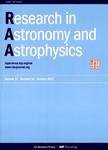Systematic analysis of low/hard state RXTE spectra of GX 339–4 to constrain the geometry of the system
Systematic analysis of low/hard state RXTE spectra of GX 339–4 to constrain the geometry of the system作者机构:Pt. Ravishankar Shukla University Raipur Chhattisgard 492010 India Inter-University Centre for Astronomy and Astrophysics Ganeshkhind Pune 411007 India Tata Institute of Fundamental Research Colaba Mumbai 400005 India
出 版 物:《Research in Astronomy and Astrophysics》 (天文和天体物理学研究(英文版))
年 卷 期:2018年第18卷第5期
页 面:37-46页
核心收录:
学科分类:0709[理学-地质学] 07[理学] 0708[理学-地球物理学] 070401[理学-天体物理] 0825[工学-航空宇航科学与技术] 0704[理学-天文学]
基 金:High Energy Astrophysics Science Archive Research Center NASA/Goddard Space Flight Center
主 题:accretion accretion disks - stars black holes - X-rays binaries - X-rays individual(GX 339-4)
摘 要:One of the popular models for the low/hard state of black hole binaries is that the standard accretion disk is truncated and the hot inner region produces, via Comptonization, hard X-ray *** is supported by the value of the high energy photon index, which is often found to be small,~ 1.7(〈 2), implying that the hot medium is starved of seed photons. On the other hand, the suggestive presence of a broad relativistic Fe line during the hard state would suggest that the accretion disk is not truncated but extends all the way to the innermost stable circular orbit. In such a case, it is a puzzle why the hot medium would remain photon starved. The broad Fe line should be accompanied by a broad smeared reflection hump at ~ 30 ke V and it may be that this additional component makes the spectrum hard and the intrinsic photon index is larger, i.e. 〉2. This would mean that the medium is not photon deficient, reconciling the presence of a broad Fe line in the observed hard state. To test this hypothesis,we have analyzed the RXTE observations of GX 339–4 from the four outbursts during 2002–2011 and identify observations when the system was in the hard state and showed a broad Fe line. We have then attempted to fit these observations with models, which include smeared reflection, to understand whether the intrinsic photon index can indeed be large. We find that, while for some observations the inclusion of reflection does increase the photon index, there are hard state observations with a broad Fe line that have photon indices less than 2.



